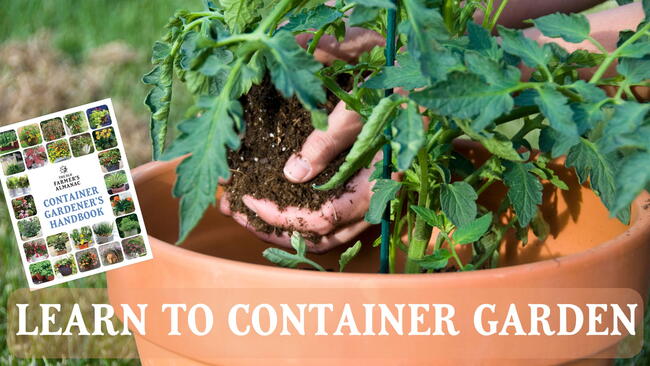How to Make a Soilless Grow Mix for Seeds
Dirt from your backyard won’t do the job for the germination of small seeds. It’s too compacted, it’s got weed seeds, and it’s not pasteurized, potentially causing disease. Most seedlings will die. Start seeds with a soilless grow mix instead. Easy to make and use, here’s information on making your own soilless mix for seeds.
You need a soilless potting mix that is fine in texture, loose, well-aerated, and free of any weed seeds or diseases. Also, the mix must be low in fertility—seeds carry their own nutrients—yet capable of moving moisture.
If you’re sowing a lot of seeds, it may be more economical to make your own seed-starting mix. It’s easy to make and use.
Seed-Starting Mix Recipe
Use the three ingredients below in the quantities shown to make a good all-round potting mix for starting seeds. All parts are measured by volume, so you can use anything you like to measure your ingredients. All ingredients are available at most nurseries and garden stores.
- 2 parts compost. You can use your own garden compost, or buy some. Break up clumps with your hands or, ideally, screen the compost to achieve a fine texture. Screening (or “sieving”) compost involves running it through a screen made of hardware cloth to separate out any materials that haven’t broken down yet. The compost will slowly release nutrients into the mix to help feed your seedlings as they grow.
- 2 parts coir (coconut fiber), or leaf mold. If you’ve purchased a block of coir, soak it in water first until it’s fibrous and easily pulled apart. Alternatively, use well-rotted leaf mold. The coir or leaf mold adds bulk and helps to retain moisture.
- 1 part perlite. Perlite makes the mix lighter and helps stop it becoming too wet. You can use sand if you prefer, but this will result in a heavier mixture.
Thoroughly mix all of the ingredients. After you make a batch, store it for later use in a lidded container or in old potting soil sacks (or any other strong plastic sack) with the top rolled down and secured. Keep it in a dry, cool place.
Using Your Seed-Starting Mix
Before you fill your pots, trays, and flats with seed-starting mix, be sure to clean them! After thoroughly washing with soap and water, rinse the containers in a solution of 1 part chlorine bleach to 9 parts water to kill remaining plant disease microorganisms that could weaken or kill your tender young seedlings. See how to clean pots and containers.
Moisten your seed-starting mix before you use it so it’s damp but not dripping. Fill your seed flats, plug trays, or pots with the mix, taking care to fill right into the corners. Gently firm the soil down. Sow your seeds according to the packet instructions.
Water carefully using a mister or a watering can fitted with a very fine rose. Alternatively, make your own watering bottle by piercing holes into the cap of a plastic bottle using a pin. This will provide a fine spray of water to gently water your delicate seeds.
Once the seedlings have germinated, water from below instead. Place containers in a shallow tray of water until the surface of the mix becomes moist, then remove.
Plants usually need potting on at least once before transplanting into their final location. When potting on you can use the same potting mix, or add worm compost or a balanced organic fertilizer for hungry plants such as tomatoes and cabbage family plants.
See our full article on how to start seeds indoors.
Container Potting Mix
For growing plants in larger containers, mix two parts garden compost with one part coir or leaf mold. Add two or three handfuls of perlite per 10 gallons of the coir-compost mix to help improve drainage. Hungry plants will also appreciate a similar amount of worm compost, or mix in a slow-release organic fertilizer according to the manufacturer’s instructions.
For long-term container plants, include loam or good quality garden soil in your potting mix. Combine one part loam (or screened garden soil) with one part garden compost, and add some slow-release organic fertilizer. This mix would be suitable for many containerized fruit trees, bushes and perennial vegetables.
Start planning your garden! Get a free trial of the Almanac Garden Planner here.








